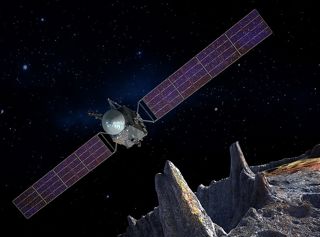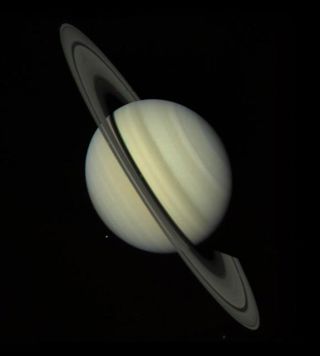What's Happening in Space: October 2023
- 29th Sep 2023
- Author: Grace Davis

A summary of space events through the month
Dhara Patel is a Space Expert at the National Space Centre, working to help share space science, stories, and topical news with our visitors and online audiences. Each month she curates a round-up of some notable space and science events coming up the weeks ahead.
October notably features the launch of NASA's Psyche mission, as well as two meteor showers...
2nd October (and 29th October) – close approach / conjunction of the Moon and Jupiter
During the morning of 2nd October, the waning gibbous moon will be in conjunction (sharing the same right ascension – coordinate) with Jupiter. At the time of conjunction (roughly 4:20am), the pair will be high in the southern sky – visible to the naked eye and through a pair of binoculars, but too far separated to be seen within the field of view of a telescope. If you aren’t an early riser, the pair will be visible in close approach from when they rise the previous evening around 7:45pm until sunrise on 2nd October when Jupiter becomes drowned out by daylight. They will be in conjunction again at the end of the month on 29th October but will have just set below the horizon at the point of conjunction. You can catch the pair in close approach in the earlier hours before sunrise on 29th October looking towards the west. Find out more about conjunctions and other astronomical phenomena in our blog written by David Southworth in our Education Team: Astronomical phenomena (spacecentre.co.uk).
8th/9th October – peak of the Draconid meteor shower
A relatively weak meteor shower with ~ 10 meteors per hour at its peak, produced by dust left behind by Comet 21P/Giacobini-Zinner. Active between 6-10th October, the shower peaks on the evening of 8th October into the early morning of 9th October. And with the Moon in its waning crescent phase there will be little moonlight interference (only in the predawn hours). It’s still worth viewing from as dark a location as possible. The radiant will appear high in the north-west falling closer to the northern horizon as the night unfolds. Find an open location with clear views facing north and look away from the radiant in the constellation of Draco to scan the entire starry canvas above as meteors can appear anywhere in the sky. A blog about the Draconid meteor shower 2023 (written by Mike Darch in our Space Comms Team) will soon be up on our website: https://www.spacecentre.co.uk/news/space-now-blog/.
10th October – close approach / conjunction of the Moon and Venus
During the mid-morning of 10th October, the extremely thin crescent moon will be in conjunction (sharing the same right ascension – coordinate) with Venus, but Venus won’t be visible in the bright daylight. Instead look for the pair a little earlier, in the hours just before sunrise – they’ll be in close approach of one and other and will be very close to the eastern horizon, so try to find a clear observing location without tall buildings/trees that may usually block your view. They’ll be visible to the naked eye but too far separated to be seen within the field of view of binoculars or a telescope. Check out the astronomical phenomena blog above to find out more about conjunctions and other astronomical phenomena.

12th October – Psyche mission launch
The Psyche mission is expected to launch on Thursday 12th October, 3:16pm (UK time), making its way to what is believed to be a unique metal-rich asteroid - the exposed nickel-iron core of an early planet (one of the building blocks of our solar system). If it is a planetesimal, asteroid Psyche may offer a close look at the interior of terrestrial planets like Earth providing a one-of-a-kind window into the violent history of collisions and accumulation of matter that created planets like our own.
If Psyche is not an exposed core of an early planetary building block, it may prove to be an even rarer kind of primordial solar system object – one that’s never been seen before. The launch period opens on 5th October with opportunities through to 25th October. Originally planned to launch on the 5th – it has been delayed a week to update the configuration of thrusters on the spacecraft. Find out more about the Psyche mission with a blog (written by Elspeth Lewis in our Education Team) that will be up on our website soon: https://www.spacecentre.co.uk/news/space-now-blog/.
14th October – new moon (6:55pm)
The new moon on 14th will occur in the constellation of Virgo. We have a blog on ‘phases of the moon’ written by Mike Darch in our Space Comms team: What are the Phases of the Moon? (spacecentre.co.uk).
21st/22nd October – peak of the Orionid meteor shower
An average meteor shower with ~ 20 meteors per hour at its peak, produced by dust left behind by Halley’s Comet. The shower peaks on the evening of 21st October into the early morning of 22nd October, and the first quarter moon will set in the west before midnight so there will be minimal moonlight interference. The meteor shower is worth viewing from as dark a location as possible. The radiant will appear low in the east rising higher into the south-east as the night unfolds. Find an open location with clear views facing east and look away from the radiant in the constellation of Orion to scan the entire starry canvas above, as meteors can appear anywhere in the sky. A blog about the Orionid meteor shower 2023 will soon be up on our website: https://www.spacecentre.co.uk/news/space-now-blog/
23rd October – Venus at greatest western elongation
Venus will be at its furthest separation from the Sun on 23rd October when it reaches greatest western elongation, making it a great time to try and spot the brightest planet in the Solar System. Look to the east during the few hours before sunrise – it will be close to the horizon, so a clear view without tall buildings and trees would be helpful. Check out the astronomical phenomena blog above to find out more about greatest elongations.

24th October – close approach / conjunction of the Moon and Saturn
On the morning of 24th October, the waxing gibbous moon will be in conjunction (sharing the same right ascension – coordinate) with Saturn. At the time of conjunction, the pair will be below the horizon, so instead look for the pair in the southern sky the evening before from sunset until around midnight when they’ll begin to set in the south-west.
They will be close to the horizon, so it would be helpful to have a clear view of the horizon without tall buildings and trees to view them easily. They’ll be visible to the naked eye and through a pair of binoculars but too far separated to be seen within the field of view of a telescope. Check out the astronomical phenomena blog above to find out more about conjunctions and other astronomical phenomena.
28th October – full moon (9:24pm) / partial lunar eclipse
Known as the Hunter’s moon (according to the old Farmers’ Almanac), this full moon marks the best time of the year to hunt, as animals would be plump from abundant food throughout the summer. Check out the “Full Moon: Full Facts” blog written by Mike Darch in our Space Comms team: Full Moons and Full Facts (spacecentre.co.uk). (Bonus: You might also be able to spot Jupiter which will be close by, just to the east of the full moon).
There will also be a partial lunar eclipse visible from Leicester which reaches maximum at 9:14pm. Unfortunately, the Earth's shadow will cover only a very small part of the Moon so you’re unlikely to see any visible change. Find out more about lunar eclipses in our blog written by Daniel Milankovic – one of our Duty Manager’s: https://www.spacecentre.co.uk/news/space-now-blog/what-is-a-lunar-eclipse/
29th October – daylight savings ends (revert from BST to GMT/UTC)
To make better use of the daylight available in the UK between March and October, an hour of daylight is borrowed from the morning and added to the end of the day, so during those months we follow BST – British Summer Time. As we head into winter we revert to GMT / UTC (Greenwich Mean Time / Coordinated Universal Time) to allow the sunrise to arrive earlier and again make better used of the shorter daylight hours. At 2:00am on Sunday 29th October the clocks will go back to 1:00am – yay, to an extra hour of sleep!

End of October – Starship next test flight?
Following the first test flight of the fully integrated Starship rocket on 20th April 2023, SpaceX have been working on numerous design changes and are readying for a second attempt. Starship is made of the Super Heavy booster – a first stage rocket with 33 of SpaceX’s raptor engines and on top of that sits the upper stage, rather confusingly also called Starship, which hosts 6 engines. And when its fully developed it will be a completely reusable rocket – both first and second stages. Back in April the upper stage failed to separate from the booster a few minutes into its first flight and SpaceX experienced a ‘rapid unscheduled disassembly’ a.k.a. an explosion.
The FAA report indicated over 60 corrective actions that needed to be made – almost half of which we related to public safety. Working with SpaceX, the FAA commented to say the modified licence that would allow Starship to launch again could be ready by mid to end of October. But a separate environmental review is needed to examine changes to launch site infrastructure, including a water deluge system intended to minimize pad damage suffered in the April launch. The FAA are hopeful that it will wrap up somewhere in proximity to the safety review. Find out more about Starship and SpaceX’s other rocketry achievements in this blog by Ed Turner in our Education team: https://www.spacecentre.co.uk/news/space-now-blog/spacex-the-world-s-rocket-giant/
